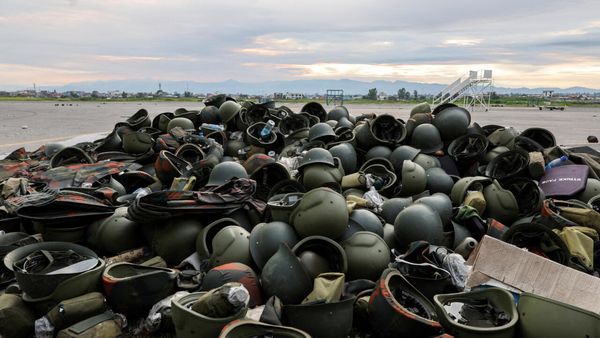Gas prices have reached a record high of $4.331 per gallon as of Friday morning (not adjusted for inflation), with the prospect of going even higher.
The big picture: The U.S. is effectively energy independent, but bans on Russian oil exports from the U.S. and other countries will have a knock-on effect in world markets.
- “Although the impact [of the ban] on U.S. supply may be limited, prices are soaring because the ban makes it more of a challenge to trade in Russian oil and more likely that other countries may follow suit,” wrote Rystad Energy's head of oil markets, Bjørnar Tonhaugen, in a note.
1) Why aren’t U.S. oil companies increasing production faster?
U.S. oil and gas production reached a record high in 2019, then plummeted during the pandemic. It was already rising again before Russia invaded Ukraine.
It's a colossal feat to re-start all that halted production, but the number of active oil rigs has grown steadily since bottoming out in 2020. Still, the rig count is far shy of the 2019 peak.
Between the lines: U.S. oil drillers haven’t returned to 2019 production levels in part because investors have called for discipline to put an end to boom-and-bust cycles of overproduction and bankruptcies.
- The industry is also suffering from broader supply chain problems and labor shortages that make it harder to rapidly scale up production, as Occidental Petroleum CEO Vicki Hollub said this week, per Reuters.
2) Can Biden open Keystone XL to lower gas prices?
Some Republicans and Canadian politicians have called on Biden to greenlight the unfinished Keystone XL pipeline, which would have brought oil from the tar sands of Canada to the U.S. Gulf Coast.
- "If President Biden had not vetoed that project, it would be done later this year – 840,000 barrels of democratic energy that could have displaced the 600,000 plus barrels of Russian conflict oil that’s filled with the blood of Ukrainians," said Jason Kinney, the premier of Canada's Alberta province — where the Keystone XL pipeline originated.
- The project was first proposed in 2008. The Obama administration rejected a permit in 2015. A new permit was issued by the Trump administration in 2019. The Biden administration revoked the permit in January of 2021.
- Less than 10% of the pipeline had been constructed as of March 2021, according to Reuters.
The bottom line: The company developing Keystone XL abandoned the project in June of 2021, and it would take years to finish if restarted now.
3) Why is Biden asking dictators to help lower gas prices?
Another avenue for the U.S. to reduce gas prices is to ask major oil producers to increase production.
Two of the biggest targets are Saudi Arabia and Venezuela, both members of OPEC, the oil cartel that tries to regulate global production and prices. The cartel rebuffed Biden requests to increase production back in November of 2021.
- Saudi Arabia: President Biden’s advisers are discussing a possible visit to Saudi Arabia this spring to help repair relations and convince the Kingdom to pump more oil, Axios' Hans Nichols reported.
- Venezuela: Some Republicans and Democrats in Washington suggest Venezuela's oil could replace Russia's, according to the N.Y. Times.
4) Who imports the most oil from Russia?
The biggest importer of Russian oil is China, followed by Germany and the Netherlands. Many eastern European countries are heavily reliant on Russian imports for oil and natural gas.
5) Who sends the most oil to the U.S.?
Canada, Mexico, Saudi Arabia and Russia export the most oil to the U.S., and Russian oil mostly goes to Hawaii and the coasts.
6) How gas prices compare when you consider inflation
Adjusted for inflation, gas was more expensive throughout much of the early teens and financial crisis era (in today’s dollars, gas was $5.31 back in June 2008).
Relative to average earnings, gas is also less expensive today than it has been throughout much of the 2000s. University of Michigan economist Justin Wolfers lays it out here.
7) Can politicians suspend gas taxes to lower prices?
Some governors and state lawmakers are looking to give people a gas tax break as gas prices continue to climb, reports Axios' Shawna Chen. Gas taxes vary by state, with Pennsylvania and California having the highest.
The big picture: Several governors are also calling on Congress to support a bill that would suspend the federal gas tax — 18.4 cents per gallon — for the rest of the year.
- "Money saved at the pump translates into dollars back in consumers’ pockets for groceries, childcare, rent, and more," six Democratic governors wrote in a letter to congressional leaders this week.
Go deeper: Soaring gas prices not yet souring demand







